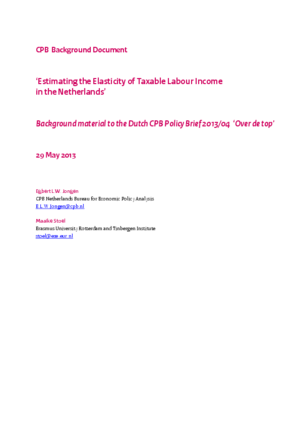May 29, 2013
Estimating the Elasticity of Taxable Labour Income in the Netherlands
We study the elasticity of taxable labour income (ETI) of employees in the Netherlands. The large 2001 Dutch tax reform generates substantial variation in marginal tax rates at different segments of the income distribution. This is background material to the Dutch CPB Policy Brief 2013/04 ‘Over de top’.
Read also the Dutch CPB Policy Brief 2013/04 'Over de top'.
We instrument the endogenous marginal tax rates with synthetic marginal tax rates using projected exogenous income. We control for exogenous income growth by including a number of socioeconomic variables, sector dummies, and log base-year income or a spline in log base-year income. For all workers we find an ETI of 0.24. For workers with high labour income the ETI rises to 0.26 (50-100K) and 0.46 (>50K). The ETI is higher for women than for men. Over all workers, the ETI is only slightly larger than the elasticity of annual hours worked, for high-wage workers the ETI is much larger than the elasticity of annual hours worked.
Downloads
English, Pdf, 1.8 MB
Authors
Egbert Jongen
Maaike Stoel
